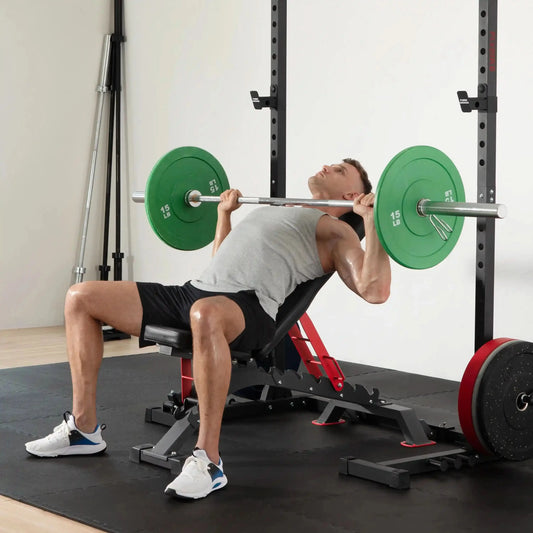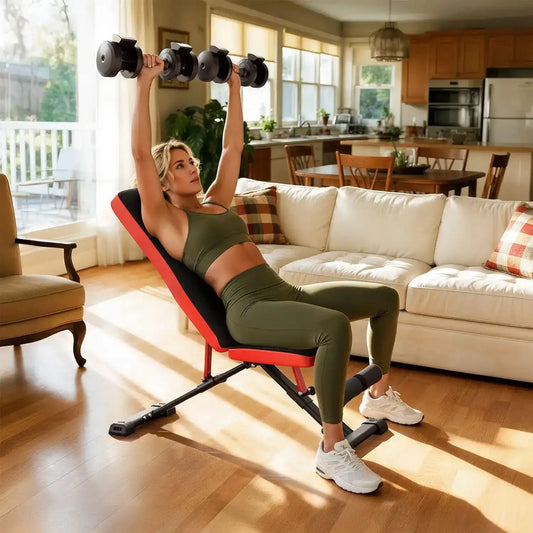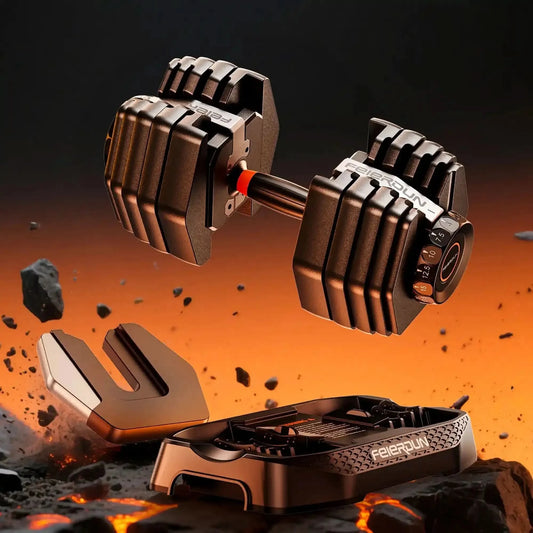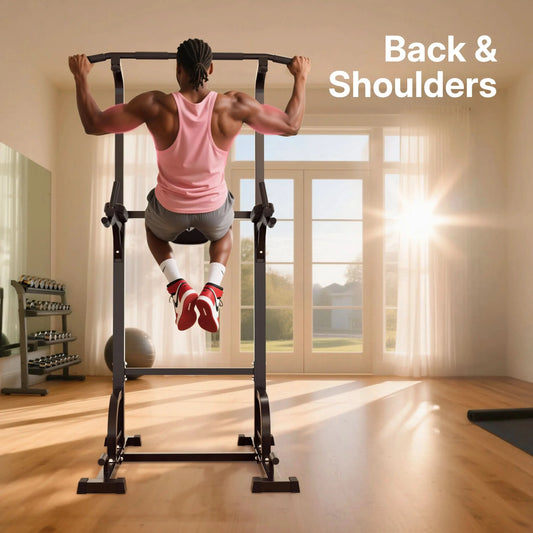Are you thinking about buying a barbell but aren’t sure which one to choose? Or maybe you want to incorporate a barbell into your training but feel overwhelmed by the wide variety available and don’t know which one suits you best. To help you solve this problem, I’ve put together this article based on my years of experience using barbells and insights from fitness experts.
Whether you’re looking to upgrade your home gym or garage gym, or you’re a CrossFit athlete or powerlifter, this practical guide is for anyone searching for the right barbell. After reading this, you’ll be able to select the best barbell based on your training goals, available space (like your home gym), and budget. Let’s get started!
First, You Need to Identify Your Fitness Goals
When choosing a barbell, you need to be clear about your purpose: Why am I buying a barbell? What do I want to achieve with it? A barbell is more than just a lifting tool—it can help you lift smarter and get closer to your fitness goals. The type of barbell you choose will directly impact both your performance and safety.
Let’s talk about the different types of barbells.
Powerlifting barbell
Powerlifting barbells are specifically designed for the “big three” lifts—squat, bench press, and deadlift. Because powerlifting focuses on testing your absolute strength, the barbell must be able to handle extremely heavy loads without excessive flex or whip.
Aggressive, well-defined knurling is essential for maintaining a secure grip throughout the lift, while a center knurl provides additional friction against the upper back during squats, helping to keep the bar locked firmly in place.
When choosing a powerlifting barbell, you should also consider features such as a durable finish, overall length, shaft diameter, bar weight, and powerlifting marks (also known as power rings). If you plan to compete, make sure the bar is officially certified by the IPF (International Powerlifting Federation).
Olympic Weightlifting Barbell
Olympic barbells are specifically designed for the two explosive lifts in Olympic weightlifting — the snatch, and the clean and jerk. Unlike general strength or resistance training, Olympic lifting demands fast, precise, and powerful movements. That’s why a standard power bar simply won’t cut it.
Olympic bars are built with a certain amount of whip (flexibility) to help balance the bar during dynamic lifts, and they’re equipped with high-quality rotating sleeves to reduce torque on the wrists and elbows.
Aggressive knurling provides the necessary grip, but center knurling is treated differently: men’s bars include center knurling, while women’s bars do not. This is due to differences in anatomy and lifting technique — center knurling on a women’s bar could cause chest abrasions during clean motions.
Just like with powerlifting bars, other important factors to consider include the bar’s weight, shaft diameter, overall length, and grip markings. If you're selecting a barbell for competition use, be sure it meets the specifications set by the IWF (International Weightlifting Federation).
CrossFit/Multi-Purpose Barbell
When choosing a multi-purpose barbell, versatility matters more than specialization. In this case, you need a bar that can handle a wide range of movements — from Olympic lifts and deadlifts to HIIT, bench presses, and squats etc.
CrossFit is known for its diverse and demanding movement patterns. That’s why your barbell needs to strike the perfect balance of durability, whip, sleeve spin, and knurling to support your performance across workouts.
Using a weightlifting or Olympic-specific barbell as a training bar in your workout routine can do more harm than good. A bar that’s too stiff may hinder explosive lifts. A shaft with the wrong diameter can throw off your grip, compromise form, and lead to premature hand fatigue.
To avoid these issues, be sure to choose a barbell that suits your training style. In addition to the ideal balance of hardness, whip, sleeve rotation, and knurling depth, most multi-purpose barbells feature dual knurl marks—allowing you to accurately position your hands for both powerlifting and Olympic lifts while keeping your grip balanced.
If the training bar you purchase doesn’t have knurl marks (also known as power rings), don’t worry—you can always add reference points using tape or string.
Don’t forget to factor in the barbell’s weight, total length, shaft diameter, and how it feels in your hands. A well-balanced, multi-purpose bar will elevate your performance and grow with your training demands.
Some people might confuse this barbell with an Olympic weightlifting bar, but they’re actually quite different. Olympic bars are known for their high whip, aggressive knurling, IWF-specific markings, and needle bearings for smooth rotation. In contrast, a CrossFit barbell strikes a balance, offering moderate whip and hardness, with medium knurling suitable for a wide range of functional movements.
Specialty Barbell
Specialty barbells are built for targeted training, offering unique designs that cater to specific muscle groups or movement patterns. For example:
- EZ Curl Bars are ideal for bicep curls and tricep extensions, reducing wrist strain during isolation work.
- Swiss Bars(or Multi-Grip Bars) focus on shoulders and triceps, offering a neutral grip to minimize joint stress.
- Trap Bars(or Hex Bars) are often used for deadlift variations or loaded jump training, allowing a more upright posture.
- Safety Squat Bars are perfect for rehabilitation or supported squat training, distributing weight more evenly and reducing shoulder strain.
Before investing in any specialty bar, it’s important to clarify your training goals. Then, consider the bar’s material quality, construction, handle position, knurling, and intended use to ensure it aligns with your fitness program.
Consider Your Home Gym Space and Equipment Compatibility
Your home gym shouldn’t feel like a gym crammed into your house — it should still feel like home. That’s why choosing the right equipment for your available space is crucial. Ask yourself:
1、What kind of exercises do you plan to do?
2、How much room do you realistically have?
3、Which existing pieces of equipment do you want to pair your barbell with?
Understanding these needs will help you select the right barbell dimensions and avoid wasting time and money on mismatched or oversized gear.
Barbell Length & Diameter:
- Olympic bars: ~2200mm length, 28mm diameter
- Powerlifting bars: 2010–2200mm; women’s bars are typically 25mm, men’s bars 29mm
- Multi-purpose bars: 1200–2200mm, with 25–28mm diameter
- Specialty bars: Customized based on purpose
Rack Compatibility: Ensure your barbell matches the specs of your squat rack or power cage. Check the interior width of your rack and confirm the bar length will fit properly. Also, make sure your weight plates are compatible with the bar’s sleeve diameter—some budget options cut corners on barbell plate aperture to save cost.
Pro Tip: If you’re planning barbell windmill-style movements or overhead presses, pay close attention to ceiling height and lateral clearance in your space.
Choose based on budget
Your home gym shouldn’t be heavy on your budget. Barbells for home come from as low as $100 to $300+. However, expensive doesn’t always mean better. Pay for only those features that you need and choose a barbell that is in line with your exercise goals and within your budget.
How much does a barbell cost?
Entry-level (Under $100):
These are great for beginners or people setting up a simple home gym. Don’t get distracted by their price, they are good for most weightlifting needs.
They can handle squats, deadlifts, and presses at moderate levels. Most options in this range come with a tensile strength range of 120,000-150,000 PSI, so they don’t expect them to do well under heavier loads.
Mid-range ($100-200):
They are the workhorses of the weightlifting industry. They are good for most lifters, are sturdy and durable, with good knurling and finish.
With tensile strength running over 190,000 PSI, they provide a sweet spot for most serious home gym owners. They can take heavier loads and more frequent use without showing any sign of wear.
If you're looking for a versatile all-purpose barbell or home gym barbell,
the Falcon Training Bar is your ideal pick. Among barbells in its price range, it stands out for its durability, load capacity, and sleek design. Whether you're pushing limits in strength training or building overall fitness, this training bar is the perfect tool to elevate your performance.
High-end ($300+):
These barbells are used in commercial settings or by serious powerlifters or Olympic lifters. They come with advanced coatings that resist corrosion and wear for years to come.
If you are training competitively, lifting heavy weights regularly, then this tire is for you. Most barbells in this range are IWF or IPF certified, ensuring performance and longevity.
Note: The price ranges mentioned above are based on a general summary of current market trends. You can use them as a reference when choosing a barbell, but keep in mind that the relationship between price and performance can be more complex. It's important to assess the actual specifications and quality of the bar before making a final decision.
Understanding the Basic Structural Features of a Barbell
Weight Capacity
A barbell’s weight capacity refers to the maximum amount of weight it can safely support without structural failure or compromising safety. The most important factor influencing weight capacity is the material of the bar.
Most barbells are made of steel, but different types of steel offer different characteristics:
Alloy steel is widely used for its high strength, fatigue resistance, and excellent elasticity, making it the material of choice for many quality barbells.
High-carbon steel has a higher hardness than alloy steel but tends to be more brittle and less elastic. It's often used in entry-level or budget bars.
Spring steel, as the name implies, offers superior elasticity and exceptional tensile strength. It's the preferred choice for high-end Olympic lifting bars due to its outstanding load-bearing performance.
In addition to material, a barbell’s diameter and length also affect its load capacity. Generally, thicker bars can handle more weight, and shorter bars tend to support heavier loads better than longer ones.
Whip (Elasticity)
Elasticity, often referred to as "whip," is a critical factor in professional or high-intensity training. It describes a barbell's ability to flex and return to form during lifts—especially during fast, explosive movements like Olympic lifts. If you're buying a bar primarily for Olympic lifting, whip should be one of your top considerations.
- Spring steel has the highest whip,
- Alloy steel offers moderate whip,
- High-carbon steel provides the least.
The thicker the bar, the less whip it has; the longer the bar, the more whip it typically allows.
For a clearer comparison, I’ve summarized these differences in the following table.
| Steel Type |
Features
|
Applicable Products |
| Alloy Steel |
high strength, durability and good resilience |
multi-functional training bar, Olympic bar, power bar |
|
High Carbon Steel |
harder but more brittle, less elastic |
entry-level training bar, commercial economical model |
|
Spring Steel |
super elasticity, extremely high tensile strength |
Olympic barOlympic bar
|
|
Stainless Steel |
strong rust resistance, no need for surface plating, direct feel |
Power Bar |
|
Aluminum Alloy |
light weight, not suitable for heavy load training |
beginner training bar, youth technical bar |
Knurling Design
Knurling refers to the textured pattern on the barbell shaft that provides grip during lifts. It plays a crucial role in both performance and comfort. Broadly speaking, knurling can be divided into three levels:
Light Knurling: Shallow and smooth, offering comfort with minimal abrasiveness. Best suited for moderate-weight training or beginners.
Medium Knurling: A balanced texture that provides solid grip without compromising comfort. Ideal for general training and lifters who train frequently.
Aggressive Knurling: Deep and sharp, delivering maximum grip—perfect for heavy lifts like powerlifting—but may cause abrasions or hand discomfort with repeated use.
From my personal experience, unless you're buying a bar for competitive lifting, medium knurling is usually the most practical choice. It gives you a secure grip while still being comfortable enough for frequent use. High-friction knurling can lead to hand injuries over time if used daily. On the flip side, if you're sensitive to grip friction or simply prefer a smoother feel, start with light knurling—or better yet, try out different bars in person to find what feels best for you.
A note on center knurling:
If you’re a male Olympic lifter, a center knurl helps add back grip during cleans and squats—so it’s worth considering.
For female Olympic bars, center knurling is typically omitted to avoid chest abrasions, due to anatomical differences and technique preferences.
For powerlifting bars, center knurling is recommended for both men and women to help with back squat stability.
For general-purpose training bars, center knurling is not essential and often left out for comfort during a wide variety of movements.
Sleeves
When you lift a barbell, the sleeves on either end are designed to rotate. This rotation helps reduce torque on your wrists and arms, making the lift smoother and safer. The rotation system inside the sleeves typically comes in two types: bearings and bushings.
Bearings: These offer fast and smooth rotation, making them ideal for explosive lifts like snatches and clean & jerks. That’s why Olympic weightlifting bars usually feature bearing sleeves.
Bushings: These rotate more slowly but provide greater stability, making them better suited for heavy, controlled lifts like squats, bench presses, and deadlifts. Powerlifting bars commonly use bushings for this reason.
Additionally, bearings are generally more expensive than bushings, which is why most training bars opt for bushings—they're practical and perfectly suited for everyday training needs.
Coating and surface treatment
Barbell coating comes in different types. From bare steel to stainless, there are various types for different grip feels and rust resistance. Some of the popular coatings include:
- Bare steel
- Black oxide
- Zinc
- Chrome
- Cerakote
- Stainless Steel
Each coating is suitable for various environments and lift needs. Zinc or stainless steel is great for garage gyms and other humid places, while bare steel is a top choice for the best grip. However, bare steel needs regular maintenance.
Based on everything we’ve covered, you probably have a much clearer idea of what kind of barbell you need.
Not all barbells are created equal—and more expensive doesn’t always mean better. What matters most is choosing a bar that matches your training needs and goals.
Ask yourself:
Do I really need this feature?
Is it worth paying extra for it?












